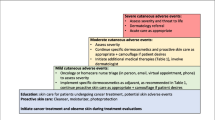Abstract
As the deadliest form of skin cancer, advanced-stage melanoma is a devastating disease. Encouragingly, with the introduction of immunotherapy, the overall survival of metastatic melanoma has improved drastically. However, access to novel immunotherapeutic drugs is not universal for all patients. Herein, we examined the association between various sociodemographic factors and the likelihood of using immunotherapy for melanoma treatment. This is a retrospective cohort study using the Texas Cancer Registry data for the years 2011–2018. Multivariable regression analysis was done to evaluate the association between patient characteristics and likelihood of receipt of immunotherapy. The association between sociodemographic factors and likelihood of presentation with metastasis at diagnosis was also examined. Having metastasis at diagnosis was strongly associated with higher odds of receiving immunotherapy (penalized adjusted OR 28.690, 95% CI 23.470–34.350, p < .0001). Compared to having private insurance, patients were less likely to receive immunotherapy if they were uninsured, had Medicare, or had missing/unknown insurance status (penalized adjusted OR’s 0.700, 0.790, 0.130, p = .026, 0.027, and p < .0001 respectively). Results from our multivariate model highlighted several factors associated with a higher likelihood of presenting with metastatic disease which included Hispanic ethnicity and black race. Dermatologic disparities affecting the Hispanic population underscore the importance of targeted interventions to overcome community level barriers to melanoma treatment and diagnosis. This study highlights the need to further evaluate different insurance types and their effect on receipt of immunotherapy.

Similar content being viewed by others
Change history
12 December 2023
A Correction to this paper has been published: https://doi.org/10.1007/s10903-023-01577-z
Abbreviations
- ICI:
-
Immune checkpoint inhibitor
- OS:
-
overall survival
- CDC:
-
Centers for Disease Control and Prevention
- SDOH:
-
Social determinants of health
- CM:
-
Cutaneous Melanoma
- TCR:
-
Texas Cancer Registry
- SEER:
-
Surveillance, Epidemiology and End Results Program
- HSR:
-
Health services region
- FDA:
-
Food and Drug Administration
- NHW:
-
Non-Hispanic White
- CI:
-
Confidence Interval
- OR:
-
Odds ratio
- BECL:
-
Biostatistics and Epidemiology Consulting Lab
References
“Key Statistics for Melanoma Skin Cancer. " The American Cancer Society. https://www.cancer.org/cancer/melanoma-skin-cancer/about/key-statistics.html (accessed.
“Survival Rates for Melanoma Skin Cancer.“ The American Cancer Society. https://www.cancer.org/cancer/melanoma-skin-cancer/detection-diagnosis-staging/survival-rates-for-melanoma-skin-cancer-by-stage.html (accessed June 2022, 2022).
Singh SRK, Malapati SJ, Kumar R, Willner C, Wang D, Analysis of “NCDB. Melanoma 2004–2015: Epidemiology and Outcomes by Subtype, Sociodemographic Factors Impacting Clinical Presentation, and Real-World Survival Benefit of Immunotherapy Approval,“ (in eng), Cancers (Basel), vol. 13, no. 6, Mar 22 2021, doi: https://doi.org/10.3390/cancers13061455.
Lam M, Zhu JW, Hu A, Beecker J. Racial Differences in the Prognosis and Survival of Cutaneous Melanoma From 1990 to 2020 in North America: A Systematic Review and Meta-Analysis,“ (in eng). J Cutan Med Surg. Mar-Apr 2022;26(2):181–8. https://doi.org/10.1177/12034754211052866.
Harvey VM, Oldfield CW, Chen JT, Eschbach K. “Melanoma Disparities among US Hispanics: Use of the Social Ecological Model to Contextualize Reasons for Inequitable Outcomes and Frame a Research Agenda,“ (in eng), J Skin Cancer, vol. 2016, p. 4635740, 2016, doi: https://doi.org/10.1155/2016/4635740.
Qian Y, Johannet P, Sawyers A, Yu J, Osman I, Zhong J. The ongoing racial disparities in melanoma: An analysis of the Surveillance, Epidemiology, and End Results database (1975–2016),“ (in eng). J Am Acad Dermatol. Jun 2021;84(6):1585–93. https://doi.org/10.1016/j.jaad.2020.08.097.
“FDA Approves New Immunotherapy for Metastatic Melanoma.“ Cancer Research Institute. https://www.cancerresearch.org/en-us/news/2011/fda-approves-new-immunotherapy-for-melanoma (accessed 2022).
Rothermel LD, Sarnaik AA, Khushalani NI, Sondak VK. “Current Immunotherapy Practices in Melanoma,“ (in eng), Surg Oncol Clin N Am, vol. 28, no. 3, pp. 403–418, Jul 2019, doi: https://doi.org/10.1016/j.soc.2019.02.001.
Larkin J et al. “Five-Year Survival with Combined Nivolumab and Ipilimumab in Advanced Melanoma,“ (in eng), N Engl J Med, vol. 381, no. 16, pp. 1535–46, Oct 17 2019, doi: https://doi.org/10.1056/NEJMoa1910836.
Steininger J, Gellrich FF, Schulz A, Westphal D, Beissert S, Meier F. “Systemic Therapy of Metastatic Melanoma: On the Road to Cure,“ (in eng), Cancers (Basel), vol. 13, no. 6, Mar 20 2021, doi: https://doi.org/10.3390/cancers13061430.
Krimphove MJ, et al. Adoption of immunotherapy in the community for patients diagnosed with metastatic melanoma,“ (in eng). J Immunother Cancer. Nov 7 2019;7(1):289. https://doi.org/10.1186/s40425-019-0782-y.
Molina G, Kasumova GG, Qadan M, Boland GM. “Use of immunotherapy and surgery for stage IV melanoma,“ (in eng), Cancer, vol. 126, no. 11, pp. 2614–2624, Jun 1 2020, doi: https://doi.org/10.1002/cncr.32817.
Moyers JT, Patel A, Shih W, Nagaraj G. “Association of Sociodemographic Factors With Immunotherapy Receipt for Metastatic Melanoma in the US,“ (in eng), JAMA Netw Open, vol. 3, no. 9, p. e2015656, Sep 1 2020, doi: https://doi.org/10.1001/jamanetworkopen.2020.15656.
Haque W, Verma V, Butler EB, Teh BS. “Racial and Socioeconomic Disparities in the Delivery of Immunotherapy for Metastatic Melanoma in the United States,“ (in eng), J Immunother, vol. 42, no. 6, pp. 228–235, Jul/Aug 2019, doi: https://doi.org/10.1097/cji.0000000000000264.
O’Connor JM et al. “Disparities in the Use of Programmed Death 1 Immune Checkpoint Inhibitors,“ (in eng), Oncologist, vol. 23, no. 11, pp. 1388–1390, Nov 2018, doi: https://doi.org/10.1634/theoncologist.2017-0673.
Al-Qurayshi Z, Crowther JE, Hamner JB, Ducoin C, Killackey MT, Kandil E. Disparities of Immunotherapy Utilization in Patients with Stage III Cutaneous Melanoma: A National Perspective,“ (in eng). Anticancer Res. May 2018;38(5):2897–901. https://doi.org/10.21873/anticanres.12536.
Ikeguchi A, Machiorlatti M, Vesely SK. “Disparity in outcomes of melanoma adjuvant immunotherapy by demographic profile,“ (in eng), Melanoma Manag, vol. 7, no. 2, p. Mmt43, Jul 16 2020, doi: https://doi.org/10.2217/mmt-2020-0002.
Jain V, Venigalla S, Reddy VK, Lukens JN, Mitchell TC, Shabason JE. Association of Insurance Status With Presentation, Treatment, and Survival in Melanoma in the Era of Immune Checkpoint Inhibitors,“ (in eng). J Immunother. Jan 2020;43(1):8–15. https://doi.org/10.1097/cji.0000000000000294.
Velasco-Mondragon E, Jimenez A, Palladino-Davis AG, Davis D, Escamilla-Cejudo JA. Hispanic health in the USA: a scoping review of the literature,“ (in eng). Public Health Rev. 2016;37:31. https://doi.org/10.1186/s40985-016-0043-2.
o. TD. S. H. Services. “Welcome to the Texas Cancer Registry: The source for Cancer Data in Texas.“ https://www.dshs.texas.gov/tcr/ (accessed 2022).
Ermer T et al. “Association Between Food and Drug Administration Approval and Disparities in Immunotherapy Use Among Patients With Cancer in the US,“ (in eng), JAMA Netw Open, vol. 5, no. 6, p. e2219535, Jun 1 2022, doi: https://doi.org/10.1001/jamanetworkopen.2022.19535.
Artiga S. Hill, Latoya, Orgera, Kendal, Damico, Anthony. “Health Coverage by Race and Ethnicity, 2010–2019.“ KFF. https://www.kff.org/racial-equity-and-health-policy/issue-brief/health-coverage-by-race-and-ethnicity/ (accessed 2022).
Dranitsaris G, Zhu X, Adunlin G, Vincent MD. Cost effectiveness vs. affordability in the age of immuno-oncology cancer drugs,“ (in eng). Expert Rev Pharmacoecon Outcomes Res. Aug 2018;18(4):351–7. https://doi.org/10.1080/14737167.2018.1467270.
Halpern MT, Ward EM, Pavluck AL, Schrag NM, Bian J, Chen AY. “Association of insurance status and ethnicity with cancer stage at diagnosis for 12 cancer sites: a retrospective analysis,“ (in eng), Lancet Oncol, vol. 9, no. 3, pp. 222 – 31, Mar 2008, doi: https://doi.org/10.1016/s1470-2045(08)70032-9.
Ward EM, Fedewa SA, Cokkinides V, Virgo K. The association of insurance and stage at diagnosis among patients aged 55 to 74 years in the national cancer database,“ (in eng). Cancer J. Nov-Dec 2010;16(6):614–21. https://doi.org/10.1097/PPO.0b013e3181ff2aec.
Shaw DL, Dhruva SS, Ross JS. Coverage of Novel Therapeutic Agents by Medicare Prescription Drug Plans Following FDA Approval,“ (in eng). J Manag Care Spec Pharm. Dec 2018;24(12):1230–8. https://doi.org/10.18553/jmcp.2018.24.12.1230.
Mahendraraj K, Sidhu K, Lau CSM, McRoy GJ, Chamberlain RS, Smith FO. “Malignant Melanoma in African-Americans: A Population-Based Clinical Outcomes Study Involving 1106 African-American Patients from the Surveillance, Epidemiology, and End Result (SEER) Database (1988–2011),“ (in eng), Medicine (Baltimore), vol. 96, no. 15, p. e6258, Apr 2017, doi: https://doi.org/10.1097/md.0000000000006258.
Hu S et al. “Disparity in melanoma: a trend analysis of melanoma incidence and stage at diagnosis among whites, Hispanics, and blacks in Florida,“ (in eng), Arch Dermatol, vol. 145, no. 12, pp. 1369-74, Dec 2009, doi: https://doi.org/10.1001/archdermatol.2009.302.
Cormier JN, et al. Ethnic differences among patients with cutaneous melanoma,“ (in eng). Arch Intern Med. 2006;166. https://doi.org/10.1001/archinte.166.17.1907. no. 17, pp. 1907-14, Sep 25.
Commission US-MBH. “Access to Health Care in the U.S.-Mexico Border Region: Challenges and Opportunities.“ https://www.ruralhealthinfo.org/assets/939-3103/access-to-health-care-u.s.-mexico-border.pdf (accessed 2022).
Dominguez K et al. “Vital signs: leading causes of death, prevalence of diseases and risk factors, and use of health services among Hispanics in the United States – 2009–2013,“ (in eng), MMWR Morb Mortal Wkly Rep, vol. 64, no. 17, pp. 469 – 78, May 8 2015.
U. D. o. H. a. H. Services, “HHS action plan to reduce racial and ethnic health disparities: A nation free of disparities in health and health care,“ ed: Washington, DC, 2011.
Acknowledgements
Texas cancer data have been provided by the Texas Cancer Registry, Cancer Epidemiology and Surveillance Branch, Texas Department of State Health Services, 1100 West 49th Street, Austin, TX 78756 (www.dshs.texas.gov/tcr). Data from the Texas Cancer Registry is supported by the following: Cooperative Agreement #1NU58DP007140 from the Centers for Disease control and Prevention, Contract #75N91021D00011 from the National Cancer Institute’s Surveillance, Epidemiology, and End Results (SEER) Program, and the Cancer Prevention and Research Institute of Texas.
Author information
Authors and Affiliations
Contributions
Fabiola Ramirez created the research question, performed the bibliography research, prepared the project design, collected the data from the TCR database, and interpreted the data analysis. In collaboration with Alok Dwivedi, Ph.D. and Luis Alvarado, M.S., completed the statistical analysis, which included the various tables. The first draft of the manuscript was written by Fabiola Ramirez and all authors commented on subsequent versions of the manuscript. All authors read and approved the final manuscript. Jessica Chacon, Ph.D. supervised the study.
Corresponding author
Ethics declarations
Conflicts of Interest
The authors declare no potential conflicts of financial or non-financial interests. The authors did not receive financial support during the preparation of this manuscript.
Ethics Approval
Texas Tech University Health Sciences Center- El Paso, Institutional review board approval was granted; IRB #: E20162.
Additional information
Publisher’s Note
Springer Nature remains neutral with regard to jurisdictional claims in published maps and institutional affiliations.
The original online version of this article was revised: the typo in first author name has been corrected.
Rights and permissions
Springer Nature or its licensor (e.g. a society or other partner) holds exclusive rights to this article under a publishing agreement with the author(s) or other rightsholder(s); author self-archiving of the accepted manuscript version of this article is solely governed by the terms of such publishing agreement and applicable law.
About this article
Cite this article
Ramirez, F., Alvarado, L., Dwivedi, A. et al. Immunotherapy Treatment Disparities: A Texas Cancer Registry Analysis of Patients with Cutaneous Melanoma. J Immigrant Minority Health 26, 23–33 (2024). https://doi.org/10.1007/s10903-023-01536-8
Accepted:
Published:
Issue Date:
DOI: https://doi.org/10.1007/s10903-023-01536-8




